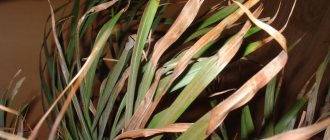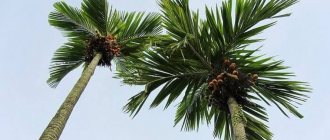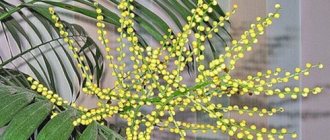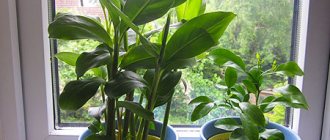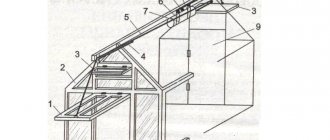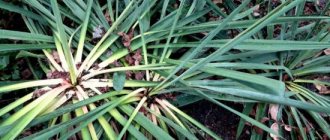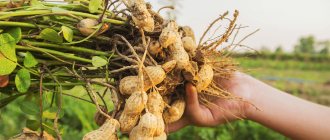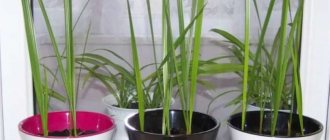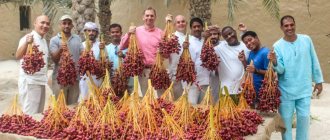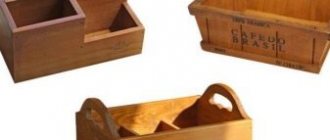In nature, palm trees reproduce by seed. The same technique is also used at home, especially since rare specimens can be purchased in modern garden centers. The germination of seed is influenced by the method of planting a palm tree at home. Some beginners note that it is very difficult for palm trees to germinate and the percentage of seed germination does not exceed 20. Professionals claim that correct agricultural technology brings up to 90% germination of seed.
Seed size
When choosing seed, beginners should be guided not by what palm seeds look like, but by how to choose a healthy specimen. Only seeds that have a fertilized embryo can sprout. It is detected at the time of stratification - mechanical damage to the peel.
When determining the size of seeds, it is worth noting that each type has its own characteristics. The smallest seeds are only 5 mm long (Washingtonia), the largest weigh more than 20 kg.
Advice ! When buying seeds, you should purchase at least 10-20 pieces to guarantee germination.
Palm tree propagation by dividing the bush
Not many palm trees reproduce by branching or dividing the bush. Among the widespread ones is, for example, Hamedorea. Other types of palm trees are either impossible to propagate in this way or too troublesome.
But in the case of Hamedorea, propagating a palm tree in this way is preferable than from seeds. This way you will get results faster. If you have to wait about six months for a sprout to emerge from the seeds, then it will take 4-6 weeks for rooting by dividing the bush. And after 4 months you will receive a young plant.
Separation of a young bush from the main one should be done during the growing season - best in May. At this time, transplantation of mature palm trees is usually carried out. So, during transplantation, you need to separate the young branch, which is located on the side. It is better to take a shoot no higher than 25 cm so that it takes root more easily. Also, a young Hamedorea bush should have flexible stems, a fully formed small branch and its own roots.
We free the roots of the adult palm tree and the shoot from the ground (so that you can see where to cut). Carefully separate the young bush using a knife, while cutting the connecting roots as close as possible to the main part of the palm tree. Sprinkle the sections with charcoal, crushed into powder.
Pour soil for palm trees or a mixture of leaf humus (2 parts), turf soil (1 part) and perlite (2 parts) into a small pot. We place the shoot there, water it and sprinkle it with soil. We also plant an adult plant, but in fresh soil.
We place the young Hamedorea for rooting in a warm place (temperature about 30-35°C). If possible, you can make a frame over the pot from thin wire and stretch a transparent bag over it to create a greenhouse. This is especially recommended if the house is not very warm even in May. If you don’t have a greenhouse, then the required humidity can be provided by constant spraying.
Watering is also needed frequently, but as the top layer of soil dries out. This is important, since excessive watering can cause the roots to rot. This is how watering a branch differs from watering a seed - it needs more soil moisture.
If you did everything correctly, then the new Hamedorea palm tree will take root within a month. But she needs to grow in a temporary pot for another 3 months to gain strength. Then it can be transplanted into a permanent flowerpot.
And, as they say, as an alaverda. Although growing a palm tree from seeds is a longer process , it is quite feasible. In addition, almost all types of palm trees can be germinated in this way. So if you have the patience, I recommend choosing the method of growing palm trees from seeds.
Article on the topic: Homemade medicinal plants and their properties. What is treated with indoor plants?
Pre-sowing seed treatment
As a rule, seed material that has undergone preliminary purification goes on sale. At home, pre-sowing seed preparation includes:
- Cleaning from pulp and shell. To do this, it is recommended to soak the seed for 1-2 days in warm water, which should be changed 6 times during the procedure. During the soaking process, the shell swells and peels off. Changing the water is necessary to eliminate inhibitors - natural substances that slow down the development of the plant.
- Stratification, in which the shell is damaged mechanically. The procedure should be done very carefully so as not to damage the delicate embryo.
- Stimulation of germination. At this stage, the seed should be soaked in clean water for 2 days. The procedure will allow the embryo to be saturated with moisture and provide strength for germination.
Important ! Treatment of seed material with complex fungicides leads to delayed germination. Before sowing seeds, it is advisable to soak them in a growth stimulator.
Planting in open ground
You can plant a palm tree on the site only when it is warm enough outside and when the likelihood of frost returning is minimal. Planting in open ground begins with choosing a location. It should be well lit. If possible, it is advisable to choose a site where there are no tall trees. It is better that the place is protected from drafts. It is recommended to treat the soil with special agents that prevent the appearance of weeds. The soil must be loose.
Seeds
Seeds can be planted directly into the ground. This is done only after the planting material has been scarified and treated with growth stimulants. As soon as the seeds are ready, you should start preparing the holes. The holes should not be too deep, but it is not recommended to plant seeds almost on the surface.
The holes must be made at a distance of 60-80 centimeters from each other. If there are a lot of seeds, you need to put 2-3 grains in each hole. This will increase the likelihood of seedlings emerging. No matter how ideal the growing conditions are, sprouts will appear in a few months at best. That's when it will be necessary to clean the plants. What is meant? Several seeds will sprout in one hole at once, and you will need to leave only one sprout, removing the rest. Growing a palm tree using the seedless method is not a labor-intensive but lengthy process, since you will have to wait a long time for the shoots to appear, and even longer for the palm tree itself to grow.
Process
Planting a shoot in open ground is the best option and, perhaps, the simplest. The roots of the plant are strong, but caution will not hurt during the planting process. First of all, you should make a hole of a suitable size: it should be approximately twice the size of the root system of the shoot. The young plant is placed in a hole so that the ground level is 2-3 centimeters above the roots. The hole is filled with soil and compacted. Then all the holes should be watered generously. To ensure that the soil always retains moisture, it is recommended to mulch it, for example, with sawdust. Thanks to this, the palm tree will not be disturbed by weeds.
Mature tree
Planting a mature tree is not easy, but it is possible. The root ball of the plant is immediately measured, and only then a hole is dug. It should be 15 centimeters deeper than the roots of the palm tree and 15 centimeters in circumference wider than the root system of the plant. The result will be a moderately deep hole.
The wrapper is removed from the palm roots and they are straightened. Afterwards you need to place the tree in the hole. The upper part of the root ball should be located slightly below ground level (2-2.5 centimeters). The palm tree must be leveled. Afterwards, the hole is filled with earth, or possibly sand-based gypsum plaster. The plant is watered and supports are made. Don't forget the mulch!
Sowing seeds
Planting a palm tree at home also involves preparing the substrate yourself. Naturally, ready-made soil for a palm tree can be purchased at a garden center. But professionals recommend preparing the following composition:
- 2 parts leaf humus.
- 1 part perlite, turf soil.
- 10 g bone meal (the amount is calculated for 10 liters of soil).
The soil mixture is used moist, but in no way wet. Seeds should be germinated in small pots. Many people recommend sowing them in plastic cups (100 ml): transparent walls will allow you to observe the development of the root system.
Depending on the variety, they determine how to properly plant a palm tree in a pot:
- Superficially, lightly pressing the seed into the soil.
- To a depth that corresponds to the diameter of the seed.
There are different germination methods that are used in commercial nurseries:
- Germination in special containers. A large amount of seed is used for sowing. After the procedure, the crops are placed in a greenhouse or covered with plastic film. Advantages - the ability to select large specimens and replant them. The disadvantage is the difficulty in controlling soil moisture, which can negatively affect crops.
- Germination in a plastic bag. The seed is placed in a bag filled with moistened peat or coconut fiber, tightly closed and placed next to a heat source. Advantages - an economical and affordable method of germination in a city apartment. The disadvantage is the inability to observe development and frequent fungal infections.
Important ! Tropical exotics require elevated temperatures (30-35 degrees Celsius). Only under such conditions do the seeds hatch.
Choosing the right palm tree
In order for a palm tree to grow, you need to choose the right species. Some plants feel comfortable in a pot, others need space, and therefore should be planted exclusively in open ground. Dwarf palms are more suitable for planting at home, since they will not take up so much space indoors. Such plants can be placed on the windowsill, or on the floor to decorate the living room, bedroom or other room.
Flower growers claim that the most suitable varieties for home cultivation are:
- “Weddell coconut” - this plant is considered the most adapted to indoor conditions;
- "ropalostylis" - has feathery leaves of a curved shape;
- “hamedorea” is a dwarf palm with several trunks and panicles of medium-sized flowers;
- “tricarpus” - has a tall trunk with brown fibers, fan-shaped leaves, long-petioled;
- “date” (not date street) - distinguished by smooth, feathery leaves that spread out;
- “Chamerops” - the palm tree has a short trunk, therefore it is low, but at the same time it has many shoots;
- “livistona” - fan-shaped leaves, the palm tree does not grow higher than 2 meters;
- “Kariota” is a low plant with leaf blades consisting of two feathers.
As for planting on the site, there is a much wider choice here. On the street you can grow both a small palm tree (the same “tricarpus”) and a huge one, which reaches a height of up to 15 meters (“royal”, “arecastrum”). © https://ydoo.info/qa/kak-posadit-palmu.html A very important factor is climatic conditions, since some need bright sunlight, while others need cold. This is also directly related to the view:
- For places with a warm climate, arecastrum, Cuban, Florida royal, sago, and palm trees from the Canary Islands are suitable. These species are resistant to temperatures as low as -5 to -7 degrees and require either partial shade or full sun.
- In places with a cold climate, “Mexican fan”, “cabbage”, “Chinese trachycarpus”, “pindo” are planted. Plants feel comfortable at temperatures from -9 to -13 degrees. In most cases they need full sun.
When choosing a palm tree by size, there are several important points to consider. There is a significant difference in price for low, medium and large plants. The most expensive are the large types. The cost of a small or medium palm tree is much lower. It is cheaper to buy a cutting or plant seeds so that you can admire the growing palm tree. If you want to decorate your landscape with a mature tree, you will have to pay a lot. In addition to the fact that mature palm trees are unreasonably expensive, planting them is also difficult: in this case, you will need a truck and a crane. Choosing a variety is the first thing you need to decide before planting.
Conditions necessary for seed germination
Seed germination requires moisture and warmth. There are certain requirements:
- Tropical varieties germinate at temperatures above 32 degrees Celsius.
- Subtropical ones require a temperature of about 28 degrees Celsius.
- Desert palm species germinate at temperatures above 35 degrees Celsius.
Some palm trees germinate in the light. That is why their seeds are not covered with soil. You can find out the specifics of sowing in the store where you purchased the material.
Advice ! The Jubaeopsis cafra palm tree is germinated only after seed stratification, Acrocomia and Lemurophoenix require high temperatures, Borassus flabellifer is germinated in very deep containers.
Caring for a palm tree in the first days after transplantation
The transplanted plant, even if it is very light-loving, is placed in partial shade for the first time after transplantation so that the lighting is not bright, but diffuse.
For the next couple of weeks following the day of transplantation, the palm tree is watered moderately, starting 2 or 3 days after the completion of the transplantation work. When the room temperature is maintained at a relatively high temperature, the plant can be lightly misted.
If the transplant is carried out according to all the rules and in compliance with the necessary recommendations, then the palm tree does not need feeding throughout the year. This statement does not apply to transplanted plants that were moved to another pot with their old earthen ball, as well as those for which only the top layer of the soil mixture was changed.
Watering and lighting
For successful seed development, moisture is necessary. The soil in the pot should be well moistened, but without stagnant water. To maintain optimal humidity, it is recommended to cover the crops with plastic film, which is removed 2 times a day for ventilation.
For the germination of some species, light does not play any role. But it is still advisable to place the crops on the windowsill, providing them with partial shade or diffused light.
What soil to buy for replanting indoor palm trees
Initially, the tropics or subtropics are considered the birthplace of many palm trees. Special climatic conditions allow the tree to grow beautiful, strong and tall.
Over time, botanists cultivated several varieties, thereby making it possible to grow plantings at home.
Caring for a palm tree is a hassle, but compliance with all growing conditions gives good results.
Let's consider what kind of soil you need to select for replanting a houseplant:
- The soil for the plant must be constantly moist.
- The soil for replanting should consist of several layers. The first layer is drainage, which allows excess moisture to escape, the second layer is rotted manure: you can take both horse and cow manure.
- The soil itself for replanting should consist of equal proportions of the following components: leaf humus, clay turf, peat soil, manure, sand and charcoal. For better growth, you need to take twice as much of the first two indicated components.
- Plant growers say: for high-quality cultivation, it is necessary to annually remove the top layer of soil and replace it with a mixture of soil and manure.
Once it has become known which soil will be most suitable for replanting the planting, you can begin choosing a pot: this will be discussed below.
Palm seed germination time
To the question of how to grow a palm tree from seeds at home, there is only one answer - be patient and wait. Some seeds hatch in the first 2-3 weeks; sprouts of other species will have to wait from several months to a year.
Planting a palm tree at home is practically the same, but germination time can vary significantly depending on the region, the length of time the seed is stored, its quality and conditions.
Advice ! The container with the crops is marked with the date on which the work was completed. Observe the appearance of sprouts, which are very clearly visible in the soil.
Possible methods of reproduction
Palm trees are propagated by seeds and vegetative methods. At home, the Robelena date can be grown from the seed.
Seed method
Suitable for all types of palm trees, but Howea, Livistona, Likuala, Trachycarpus and Washingtonia reproduce only by seeds. This method is time-consuming and labor-intensive. Here's what the process looks like step by step:
- Choose large, whole and fresh seeds. The longer they are stored, the lower their germination rate.
- Seed material is soaked for 5 days.
- Disposable cups are filled with a soil mixture of vermiculite, leaf soil and perlite in equal parts. A small hole is drilled at the bottom. You can plant it in a large container.
- The seed is immersed 2 cm into the ground. Moisten the soil with a sprinkler.
- The crops are covered with film to create a greenhouse effect.
- The cups are placed in a warm place, regularly ventilating and watering the soil.
- As soon as the sprouts appear, the containers are moved to a bright place.
- After rooting and the appearance of full-fledged leaves, the plants are transplanted into permanent pots.
Seeds germinate slowly, the process sometimes drags on for several months.
Root shoots
Suitable for palm trees growing as a bush: Hamerops, Chrysalidocarpus, Roblena, Carita, Date, Hamedorea. This method is used during the growing season, when plants are actively growing and developing. Select a root shoot near the mother bush. It is separated with a sharp knife. The cut is sprinkled with crushed activated carbon to disinfect the wound.
The seedling is placed in a prepared pot with soil, placed in a warm place and covered with film for rooting. At this time, the shoot is regularly watered abundantly and periodically sprayed. You can move a young palm tree to a permanent place in a ventilated room only after successful rooting and the appearance of the first leaves.
Tops
Yucca and Dracaena are propagated. For the soil substrate, mix two parts of garden soil and one part each of humus and sand. Cut off the top, free the trunk from leaves and place it in the prepared soil mixture for rooting.
The survival rate is very high – up to 90%. The container is covered with film or glass and placed in a warm, bright place. When the first leaves appear, remove the cap and place the pot in a permanent location. Next, they are cared for as if they were an adult palm tree.
How to prune dracaena correctly at home
When shortening the central stem, you need to take into account several points: the top with green leaves should be in a zone of comfortable lighting, so the height of the trunk is calculated for the future growth of branches and leaves; for new shoots to appear, it will be necessary to provide the necessary conditions for the germination of new shoots from dormant buds; all operations to prepare the correct cut and seal it are carried out under sterile conditions.
Any part of the leafy or bare trunk is cut off. The removed area can be rooted by obtaining another copy of dracaena. Pruning dracaena for branching as an operation is carried out with a sharp knife without squeezing the tissue.
After the top part of the plant is cut off, it can be used to root the top, or cut into 7-10 cm pieces, each of which is capable of producing a new plant. The requirement to cut only with a sharp knife and even cuts is mandatory.
If the stem is leafy at the cut site, the leaves must be removed by 10-15 cm, exposing the trunk. Cover the cut area with garden pitch or melted paraffin so that the inner layer does not evaporate moisture or dry out. The rudiments of new branches should form on the cut. There can be from two to five. But not all germs will grow. The number of new formations depends on the conditions under which germination occurs.
Conditions for germination: treatment of the stem with water with the addition of a growth stimulant, for example, Epin; creating a damp moss cushion around the open cut of the cambium, the waxed part should be open; a plastic bag is tightly secured on top, creating a constant humidity of 75% inside; The plant is kept in the light at a temperature of 22-25 degrees for a month.
It is important at this time not to open the cut site, not to remove the bag, and not to change the germination conditions. At the same time, the remaining leaves require watering, and the stem also needs to be moistened. Watering is carried out only by the bottom method, draining the remaining water that has not been absorbed into the earthen lump. It is important that germination is carried out in the light.
As soon as the plant produces buds at the cut site, it is ready to continue development without additional shelter.
It is not necessary that new branches will develop from all the buds that have hatched. Some will not have enough nutrition and will wither away. But you can prune the plant this way many times, renewing it and giving it a new shape. If the plant has a bare stem, then it is completely placed in the bag after abundant watering. The bag is not removed until the seedlings appear, so as not to disturb the microclimate. The plant is watered through a tray.
Is it necessary to prune dracaena at home?
The plant looks well-groomed if it is regularly pruned and shaped. Therefore, pruning is one of the mandatory operations for caring for dracaena. It happens that a plant develops deformed shoots, they should be removed.
Then, instead of them, the plant will send out new shoots, more foliage is obtained, and the plant takes on new forms. Any areas with pests and diseases should be removed immediately to prevent infection of the entire plant. This operation is called sanitary pruning.
How to choose a pot for a palm tree
The palm tree, despite the fact that in this case it is a houseplant, grows very quickly, therefore, get ready for the fact that every 2-4 years, you will have to replant it into a larger container, as much as it does not like it. Therefore, buying expensive pots is not entirely appropriate, because after a few years you will have to replace them.
In addition, when choosing a pot for a palm tree, choose it so that in the future you can easily get the palm root with an earthen lump from there, and not damage the root system of the plant, therefore, it is better to choose a plastic container - you can use it cut without much difficulty, whereas in the case of a ceramic pot, you will have to break it, which is not entirely safe for you and your exotic flower.
Also, as for ceramic pots, although they look prettier than plastic ones, the earthen ball in them dries out faster, therefore, in such a ceramic pot, especially if the ceramics are not glazed inside, you will have to water your palm tree more often.
As for the color of the pot, it is better to choose light shades, but if you are a supporter of dark color pots, then you will need to place it in a light-colored pot - then the roots of the palm tree will not overheat.
Don't forget about the special drainage holes at the bottom of the pot - without them, moisture will accumulate and the roots of the plant will begin to rot.
Well, regarding the size of the pot, small plants cannot be planted in large containers. So, for a small sprout a pot with a capacity of 200 milliliters is suitable, then 400 milliliters and 500... All subsequent plant transplants should increase the volume of the pot by no more than 25-30%.
Why can’t you plant a small flower in a large pot (after all, this way you will prevent subsequent plant transplants and relieve the flower itself from stress)? A plant in such a pot will most likely die, since its root system will begin to rot from excess moisture. Well, if it ends up in too small a pot, then it will stop developing
Features of cultivation
Soil selection
When choosing a substrate for planting an exotic plant, you should pay attention to both its composition and the acidity of the environment, which should be neutral or slightly acidic. This will provide better conditions for the growth of rapeseed.
The best option would be to use purchased soil for palm trees.
For those gardeners who want to independently prepare a substrate for Asian shrubs, you can use the following ingredients: peat soil, turf soil, compost soil and river sand in a ratio of 2:2:2:1.
Location and lighting
The place for placing the pot with rapis should be well lit. In the summer, it is recommended to expose rapis outdoors, and it is necessary to place the flowerpot so that the plant is not exposed to direct sunlight, which can cause the leaves to burn.
In the summer, a balcony, veranda or flowerbed will be an excellent environment for the growth of rapeseed. It is possible that under such conditions the palm tree will even bloom, which happens extremely rarely when grown indoors.
In order for the leaves of your home palm tree to grow evenly, you should regularly rotate the pot, ensuring that the shrub is evenly illuminated by sunlight.
A plant that has been grown in a store for some time should not be immediately exposed to the sun when moved home: keep the pot in partial shade for a couple of weeks and gradually increase the light intensity.
Temperature, humidity, watering
The advantage of the bamboo palm is that the plant can quickly adapt to environmental temperature conditions. Rapis will retain its decorative properties even if it is kept at a temperature of +10°C in winter. However, in winter, it is best for rapeseed to be kept in a room with a temperature of +12...+16°C.
In summer, during the active growth phase, temperatures within +20...+25°C will allow the plant to feel as comfortable as possible. If the temperature exceeds optimal values, gardeners should regularly ventilate the room, making sure that the plant is not exposed to drafts that could harm the palm tree. It will also be necessary to ensure optimal humidity by regularly spraying the rapis with settled water and gently moistening the leaves with a cloth soaked in water.
During the summer months, you should water the shrub with plenty of water to completely wet the soil in the pot. It is also necessary to carefully ensure that the soil remains moist and does not dry out. In winter, you should water rapis less often, but you should also not allow the earthen ball to dry out.
The water used to water the bamboo palm should be soft, settled and at room temperature.
Fertilizers and fertilizers
From April to early September, rapeseed needs fertilizing, which is recommended once every 2 weeks. For these purposes, you can use complex fertilizers for palm trees. During the dormant period there is no need to feed the exotic plant.
Transfer
The process of transplanting the painting should only be carried out if the plant has become too large for the pot. This is explained by the fact that the palm tree does not tolerate annual replanting quite well, this negatively affects its growth and development. This procedure is carried out in the spring.
Please note that during transplantation it is necessary to preserve the earthen ball on the roots of the rapeseed, which will protect the root system from damage and prevent the death of the plant.
The container into which the transplant will be carried out should be wide, but not very deep. A deep pot can cause stagnation of moisture and then lead to disruption of air permeability and damage the root system of the bush.
Drainage should be provided in the new flowerpot. For this, it is recommended to use expanded clay or small crushed stone; it is better to use pebbles.
After transplantation, the bush is quarantined for 14-20 days. During this period, you should maintain optimal air humidity, spray the leaves, moisten the soil, ventilate the room and apply fertilizer.
Article on the topic: Hemanthus flower: home care, photos, reproduction and types: white-flowered
Also, after transplanting, gardeners are recommended to mulch the soil using sphagnum moss. This will keep the soil moist for a longer time.
Trimming
To preserve the decorative properties of the shrub, you should regularly get rid of yellowed, old and fading leaves, pruning them at ground level. After pruning, you should not water the rapis for several days, since water getting into the cut area can cause the process of rotting and cause the death of the palm tree.
Winter care
In winter, it is necessary to use steam generators that will humidify the air, which will lack moisture due to heating devices.
In winter, rapeseeds do not need to be fertilized.
To ensure a comfortable temperature for rapeseed in winter (+12...+16°C), you should keep the plant away from radiators.
You can increase the plant's daylight hours using special fluorescent lamps.
Diseases and pests
Rapis can be affected by the following pests:
- spider mite: drinks the sap from the plant, causing black spots and white webs to appear on the stem and leaves. This parasite occurs under conditions of low air humidity in the room where the palm tree grows;
- Scale insects: also suck the juice from rapeseed leaves. Insects quickly form a dense growth on the leaves, which leads to browning of the leaves;
- Mealybug: forms cotton wool-like clumps on the plant.
In order to get rid of pests and not damage the delicate leaves of the plant, use a soap solution or alcohol, which is used to wipe the petioles and leaves of rapeseed.
If these remedies do not help, you will have to apply special pest control chemicals to the plant.
Rapis is a plant that will be a wonderful decoration for every home; it will complement interiors designed in a classic style especially well. Low rapis will look good next to other ornamental plants, such as ficus or sansevieria. Tall rapis looks great as an independent decorative element.
Among the special advantages of rapeseed, one should also note the plant’s ability to secrete phytoncides that benefit humans.
Do not deny yourself the pleasure of growing beautiful rapis at home. If you follow all the recommendations for caring for an exotic shrub, it will delight you with its beauty for many years.
